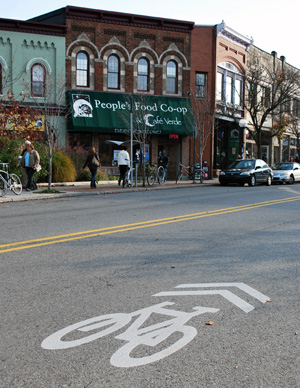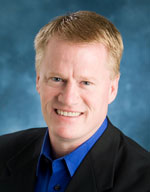Washtenaw County board of commissioners meeting (Nov. 16, 2011): The main item on the Nov. 16 agenda was a final vote on the two-year budget for 2012 and 2013. Despite extensive public commentary – mostly from supporters of the Humane Society of Huron Valley (HSHV), and various nonprofits that provide human services like food and housing for low-income residents – there were no amendments that changed funding allocations from the version of the budget given initial approval two weeks ago.

Kirk Tabbey, left, chief judge of the 14A-2 District Court in Ypsilanti, talks with Washtenaw County commissioner Dan Smith, vice chair of the county board's Ways & Means Committee. Smith chaired the Nov. 16 Ways & Means meeting in the absence of chair Rolland Sizemore Jr. Tabbey was on hand to introduce his new court administrator, Robert Ciolek, who replaces former court administrator Gene DeRossett. (Photos by the writer.)
The $97 million general fund budget included a range of funding cuts, aimed at overcoming what had been a $17.5 million deficit for the two-year period. Discussion focused for the most part on cuts to HSHV and Head Start, and drew sometimes heated rhetoric from commissioners – primarily from Ronnie Peterson. He advocated vigorously for support for both entities, but did not offer specific alternatives for funding.
The budget reduced HSHV’s contract from $500,000 this year to $250,000 each year in 2012 and 2013, an amount that HSHV officials have said doesn’t cover the cost of the services they provide. The state mandates that counties provide certain animal control services, but there’s disagreement between the county and HSHV about what those mandated services entail.
The HSHV’s current contract expires on Dec. 31, and the two groups continue to negotiate. Meanwhile, the county’s attorney has drafted a request for proposals (RFP) to solicit bids for animal control services. That RFP is being reviewed by other county officials – including the sheriff and prosecuting attorney – and will likely be issued within the next week or so.
Head Start’s situation remains unchanged, and the county will likely hand off the local program to federal administrators at the start of 2013. During deliberations, Peterson raised a range of concerns over how a transition would be handled, its impact on employees and children in the program, and the county’s debt obligations on the Head Start building in Ypsilanti.
Board chair Conan Smith lobbied for the county to explore other options, including keeping the federal grantee status but designating a single sub-recipient to administer it. There’s also new state legislation that could allow for creating an intergovernmental consortium – perhaps in partnership with the Washtenaw Intermediate School District and the University of Michigan – to fund and operate the program. Smith proposed an amendment would have required a vote of the board before relinquishing control of the Head Start program, but that amendment failed. A majority of commissioners felt it would simply delay the inevitable.
The only amendment that passed involved re-hiring of retired employees. The amendment was initially proposed by Dan Smith, then approved in a modified form to require the county administrator to report to the board when retirees are hired back on a temporary basis. The issue will come to the fore as roughly 100 of the county’s 1,300 employees are expected to retire in the coming weeks, a situation described by Conan Smith as a potentially catastrophic loss of institutional expertise. The practice of hiring retired staff on a temporary basis is likely to be used to manage the transition. County administrator Verna McDaniel said she plans to use the turnover as an opportunity to restructure county operations in some areas.
Related to that turnover is the possibility that McDaniel will approve 8% raises for certain employees who take on extra work. Ronnie Peterson cautioned that giving raises in the wake of getting salary and benefit concessions from employees will hurt morale, and make labor unions less likely to agree to additional concessions in the future. The county is projecting deficits of $11.6 million in 2014 and $14.7 million in 2015.
The final budget vote was unanimous, though three commissioners voted no on specific line items. (Rolland Sizemore Jr. was absent.) Peterson, Felicia Brabec and Alicia Ping voted no to cuts for animal control services. Peterson and Brabec also voted no to cuts for Head Start and the coordinated funding of human services. Conan Smith voted no to the line item for the board of commissioners, referring to it only by the line item number. He later said he’d been joking. [.pdf of 2012-2013 general fund budget]
The Nov. 16 meeting included several items not directly related to the 2012-2013 budget. Public hearings were set for brownfield plans at Ford Motor Co.’s Rawsonville plant and the Arbor Hills Crossing development in Ann Arbor. The board also gave initial approval to comply with the state’s “80/20″ rule, which will require about 95 employees represented by five collective bargaining units – those that did not agree to labor concessions – to pay for a greater amount of their health care costs.
The board gave initial approval to issue bonds for a new $3.2 million facility to be operated by the Western Washtenaw Recycling Authority (WWRA). The topic of county-issued bonds also arose during public commentary, when a resident of Sylvan Township asked what would happen now that township voters rejected a millage intended to repay the county for bond payments on a water and sewer facility. The answer? It’s not yet clear, commissioners said. [Full Story]







